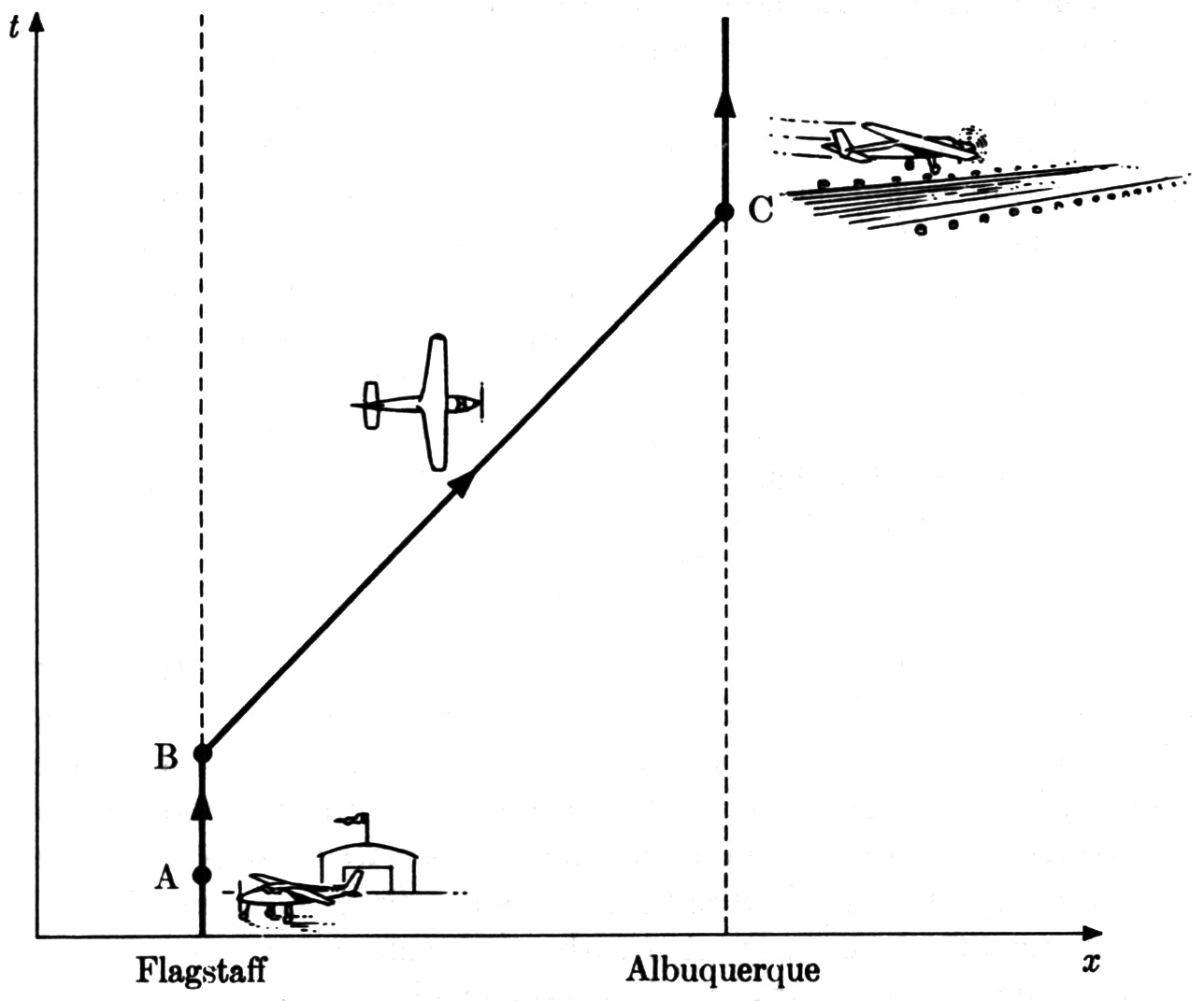
World-line diagram: a trajectory in a spacetime map.
I have attached arrows to the world line of the airplane. They may seem redundant, since there is, after all, only one possible direction to move through time—forward. But the arrows do no harm and will serve a useful purpose in the fundamental-particle world.
This simple spacetime map describes motion only along a single straight line, but that will be sufficient for understanding particle interactions. We may imagine more complicated maps with two or even three space dimensions and one time dimension; but it is better to restrict the diagrams to the form illustrated here.
Turning now to the small-scale world, I present world lines of some simple occurrences in the figure below.
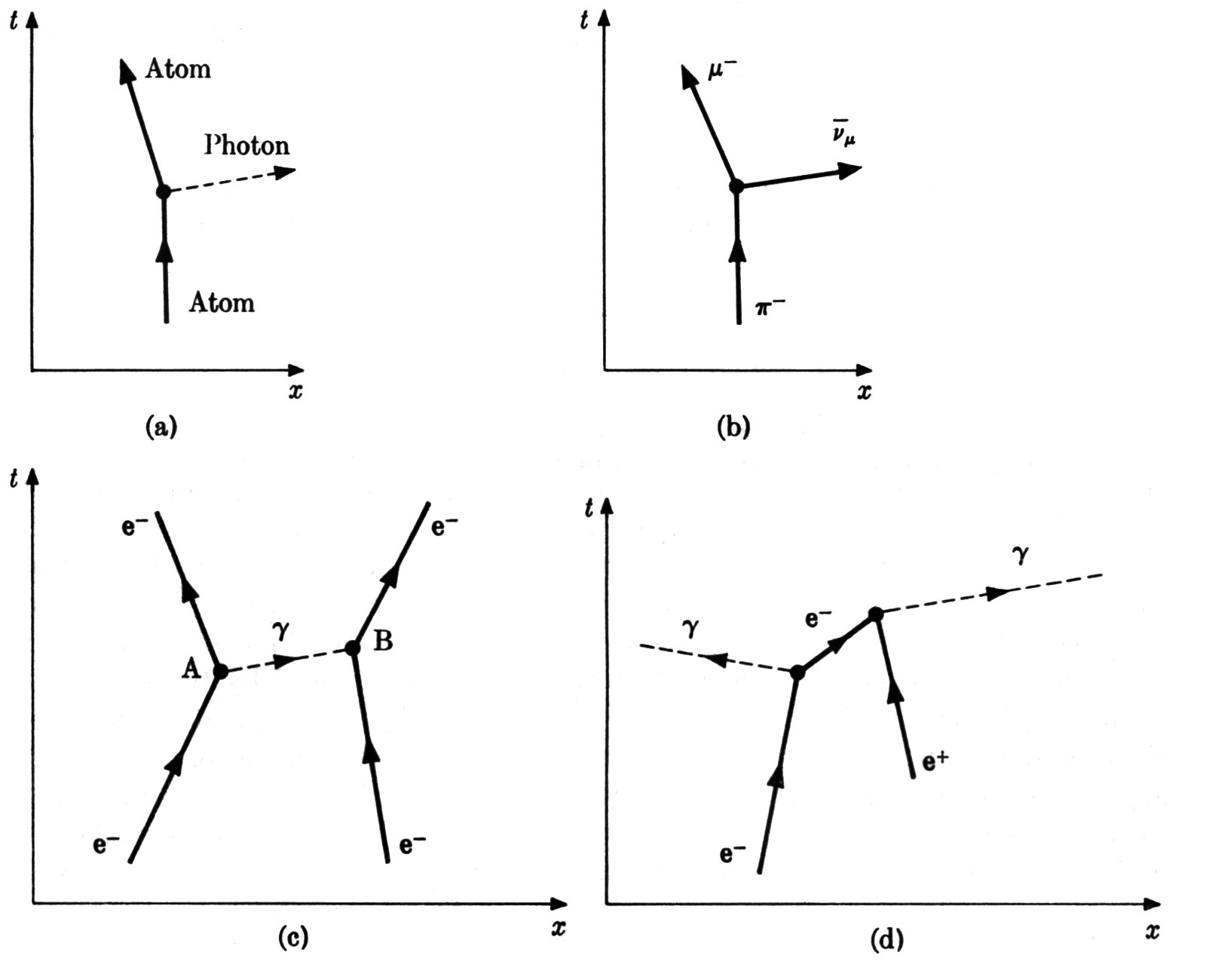
World lines of some occurrences in the particle world. (a) Emission of photon by an atom. (b) Pion decay. (c) Scattering of one electron by another. (d) annihilation of an electron and a positron.
Diagram (a) shows the process of photon emission by an atom. Initially (starting at the bottom of the diagram) an atom is at rest and, like the city of Flagstaff, traces out a straight vertical world line. It then emits a photon that flies off to the right; the atom itself, having fired the photon, recoils and moves off more slowly to the left. Note that the more slowly a particle moves, the more nearly vertical is its world line—no motion at all is exactly vertical. Conversely, the faster the particle moves, the more its world line is tipped over toward the horizontal. But it can never become exactly horizontal; for that, the particle would have to travel from one place to another in no time at all. The photon line is tipped the maximum amount; the inverse of its slope is the speed of light.
Diagram (b) illustrates pion decay:
π– → μ– + νμ .
At some point, indicated by the black dot, the negative pion ceases to exist. It is annihilated and its world line terminates. But at that same place and same time (that is, at that same point in spacetime) the negative muon and the antineutrino are born and fly apart, the antineutrino line being tipped almost as far as a photon line (since it moves at nearly the speed of light). The black dot locates an event, an occurrence at a single point in space and time. In each of the other diagrams, there are also important events. In the world of particles, every significant event is marked by the creation and/or annihilation of particles.
Diagram (c) illustrates one of the processes that contributes to the “scattering” (deflection) of one electron by another. At point A, an electron emits a photon—a virtual photon—that is absorbed by another electron at point B. The photon here plays the role of an “exchange particle.”
Diagram (d) shows the process of positron-electron annihilation,
e– + e+ → 2γ.
This time the photons are real, not virtual. The diagram illustrates a feature of all events of the particle world when examined most closely (with the highest-power microscope, so to speak). Each basic event is a “three-prong vertex,” at which two fermion world lines (the electrons, in this case) and one boson line (the photon, in this case) meet.
Diagrams (b), (c), and (d) above represent, so far as we know, what is really going on at the smallest-scale level. Not so, diagram (a). An atom is not itself a fundamental particle, so its world line is really a bundle of world lines. This means that the black dot in diagram (a) represents more activity than the diagram shows. It is “cover” for finer-grained mesh of events. We must be prepared for the possibility that the future will reveal an inner structure for other apparently simple events, even for the possibility that the apparently catastrophic acts of sudden annihilation and creation really result from a smooth, continuous flow of events over tinier regions of space and time than it has been possible to investigate so far. This is pure speculation. Down to the shortest distances (~ 10–17 m) and shortest times (~ 10–25 s) to which scientists have so far probed, the basic events of the particle world still seem to be the catastrophic events of sudden creation and destruction of the packets of field energy we call particles.
The accumulated evidence from experiments probing the world of the very small, together with the confirming support of the quantum theory of fields, leads to the following important general conclusion: All of the interactions in nature arise from acts of annihilation and creation of particles at definite points in space and time. There are actually two important ideas here. First, all interactions involve the creation and annihilation of particles; second, these creations and annihilations do not take place over a region of space or over a span of time, but are instantaneous and localized at points. By an “interaction” I mean simply the influence of anything on anything else. Thus, all ordinary forces—pushes or pulls of one thing on another—are interactions. Also, the decay of an unstable particle is the manifestation of an interaction. The final particles are “influenced” by the initial particle—they come into existence only because the initial particle was there.
Contrast this new view of interactions with the classical view. The Sun and the Earth “interact,” for the Earth is pulled by the Sun. Nothing is apparently being created or destroyed, and nothing seems to be happening instantaneously at isolated spacetime points. But, according to the new view, gravitons are constantly being emitted and absorbed, both by the Sun and by the Earth. Each act of emission or absorption occurs at an instant of time and a point in space. The “force” the earth experiences is nothing but the accumulated effect of all of these graviton interactions.
To turn to an example in the particle world that is more surely understood, consider the scattering of two electrons. According to the old view, the electrons approach each other, feel a mutual repulsive force, and are deflected. The new view, illustrated by diagram (c) above, goes deeper; it explains “why” the electrons exert forces on each other. In that diagram you see two electrons approaching one another. At point A, the electron on the left emits a photon and changes its speed. At point B, the electron on the right absorbs the photon and changes its speed. The two electrons have interacted, or exerted forces on each other, since their motion is altered. It was the exchange of a photon that brought about this apparent interaction. Strictly speaking, the basic interaction was not between the two electrons at all, but between each electron and a photon. The second electron is only indirectly aware of the presence of the first. The old idea of action at a distance, of a force “reaching out” from one to the other, is completely abandoned. It is replaced by the idea of a “local interaction,” of each electron interacting locally—that is, at its own location—with a photon.
Of course, that particular diagram is only one of many; the others involve more complicated exchanges between the electrons. The net effect of all the possible exchanges is the deflection of the electrons according to the ordinary repulsive electric force, but with motion that is a series of hops rather than a smooth flow.
According to the present theory of the interactions of electrons and photons, diagrams (c) and (d) above are pictures of what “really” happens on the submicroscopic scale. Such diagrams are called Feynman diagrams, after Richard Feynman, who showed in 1949 that such pictures have an exact correspondence to mathematical expressions in the field theory of electrons and photons. These diagrams, therefore, portray what is “really” happening, and provide a convenient way to catalogue the various possible processes of creation, annihilation, and exchange.
The key points of a Feynman diagram are the “vertices,” representing those spacetime points at which (in this example) photons are created or absorbed. All processes involving photons, and therefore all of the interactions associated with electromagnetism, arise from elementary events of photon creation or photon annihilation. These fundamental interaction events can be pictured by a single kind of vertex that looks like either of the diagrams in the figure below. The solid lines represent charged particles and the dashed line represents a photon. Vertices like these can be recognized in diagrams (c) and (d) above.
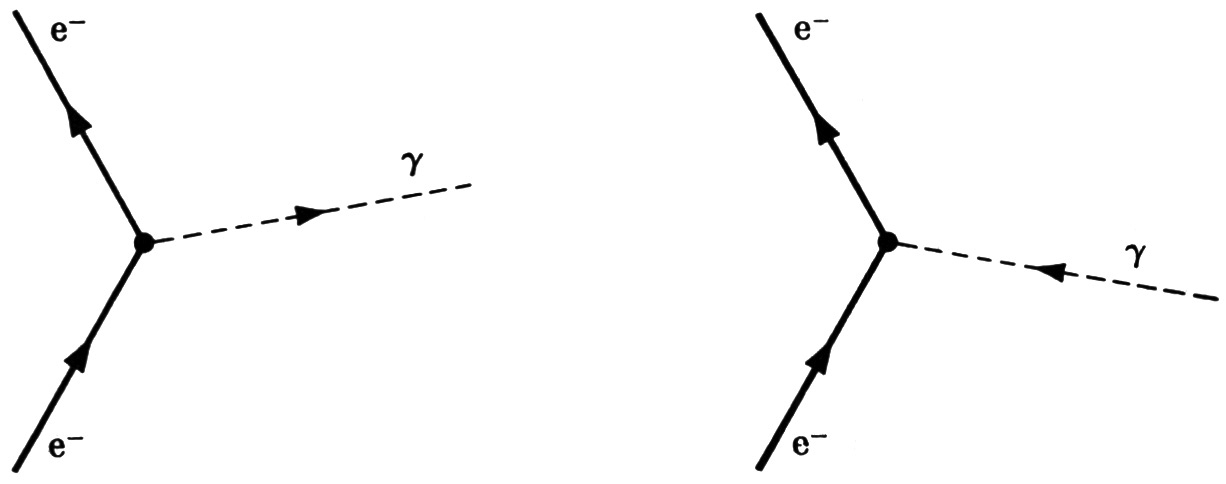 Basic electron-photon interaction vertices.
Basic electron-photon interaction vertices.
If the solid lines represent the world lines of electrons, for example, it appears that the fundamental interaction event may be regarded as an event in which a photon is created or absorbed, and an electron simultaneously changes its state of motion. There is, however, a more general and more fruitful interpretation. The vertex may be taken to represent a point where the world line of one electron terminates and the world line of another begins. According to this view, the vertex represents a truly catastrophic event. Nothing survives it. Instead of thinking of a single electron being changed at the vertex, one can think of one electron being destroyed and another electron being created. Since all electrons are indistinguishable, it has no real meaning to say that the outgoing electron is the same as or different from the incoming electron. To think of the outgoing electron as a new and different electron, however, corresponds more closely to the mathematical theory of the fundamental interaction. The creation-destruction interpretation also leads to a simple, unified description of particle events and antiparticle events.
The vertex on the right in diagram (d) above seems to be different. Instead of being a point where one electron world line ends and another begins, this vertex is a point where both an electron world line and a positron world line end. There is a simple artistic trick by which we can change the picture significantly. Suppose we turn around the arrow on the positron line. The arrowhead was, after all, redundant, since all particles move forward in time. We can use it instead as a label to distinguish particles from antiparticles. An arrowhead pointing in the “correct” direction will indicate a particle (for example, an electron); an arrowhead pointing in the “wrong” direction will indicate an antiparticle (a positron).
Using this revised notation, we show in the diagram below an electron-positron annihilation vertex and an electron-positron creation vertex. These vertex diagrams involving positrons look like twisted versions of the fundamental vertex diagrams illustrated above. The generalized conclusion is that the fundamental electron-photon vertex with its limbs twisted in all possible directions in spacetime represents all the possible basic interactions among electrons, positrons, and photons. This provides a magnificently simple and general view of the underlying basis of all electromagnetic phenomena.
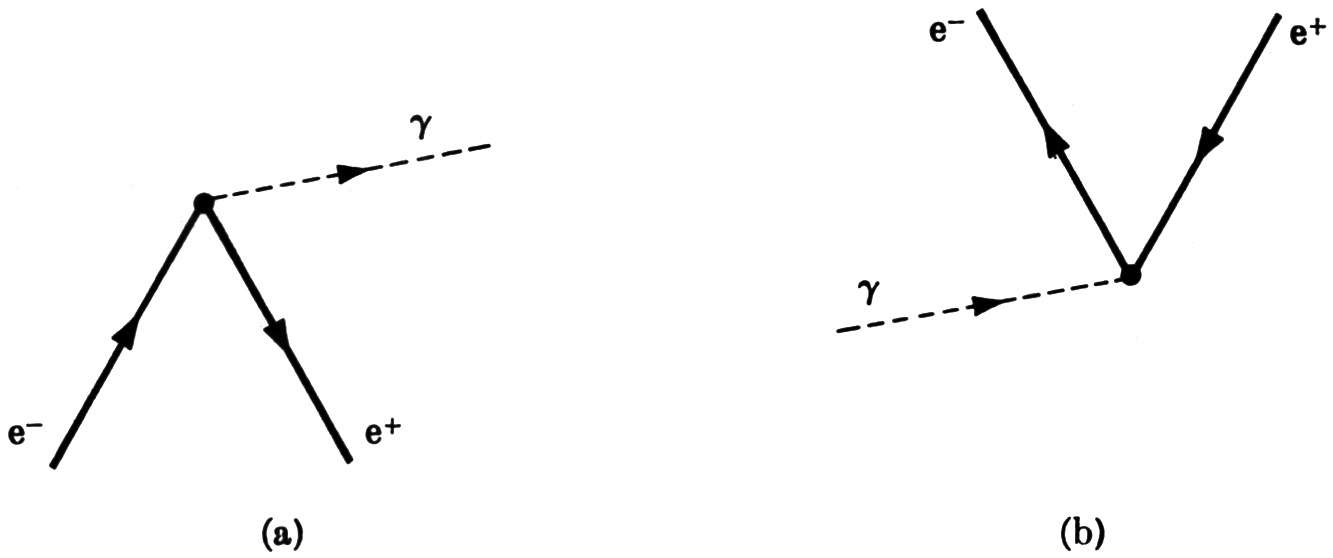 Additional fundamental electron-photon interaction vertices that include antiparticles (positrons).
Additional fundamental electron-photon interaction vertices that include antiparticles (positrons).
What Feynman showed when he discussed the connection between such world-line diagrams and the structure of the mathematical theory of the electron-positron-photon interaction was that the device of the reversed arrowhead is much more than an artistic trick. According to the field theory of electrons, the creation of a positron is “equivalent” to the annihilation of an electron (they are not identical processes, but the theory says that whenever one can happen, the other must also be able to happen). Moreover, the mathematical description of a positron field propagating forward in time is identical with the description of an electron field propagating backward in time. It is perfectly possible and consistent to think of particles moving backward in time as well as forward.
This circumstance need not lead one to deep philosophical conclusions, although philosophical implications are hard to escape. The positron may be described as an electron moving backward in time, but it does not have to be so described. An alternative description is equally possible in which the positron is a normal particle moving forward in time. Nevertheless, this picture of backward motion in time is a tantalizing one that simplifies the view of elementary interactions and provides a “natural explanation” for the existence of antimatter. Consider the Feynman diagram illustrated below, for example. According to the normal view of time unrolling in one direction, you start at the bottom of the diagram and read up. (Put a horizontal straight edge over the bottom of the diagram and move it slowly upward, noticing what lines it touches.) First an electron and a photon are approaching each other. At vertex A, the photon creates an electron-positron pair. The new electron flies away, while the positron collides with the first electron at vertex B. There they undergo mutual annihilation and a new photon is born.1 The alternative view, which Feynman showed to be also consistent, is to picture the first electron proceeding to point B, where it emits a photon and reverses its path through time. It “then” travels to point A, where it absorbs the incoming photon and once again reverses its course through time, flying off in the “correct” direction. Either view is permissible and logically consistent.
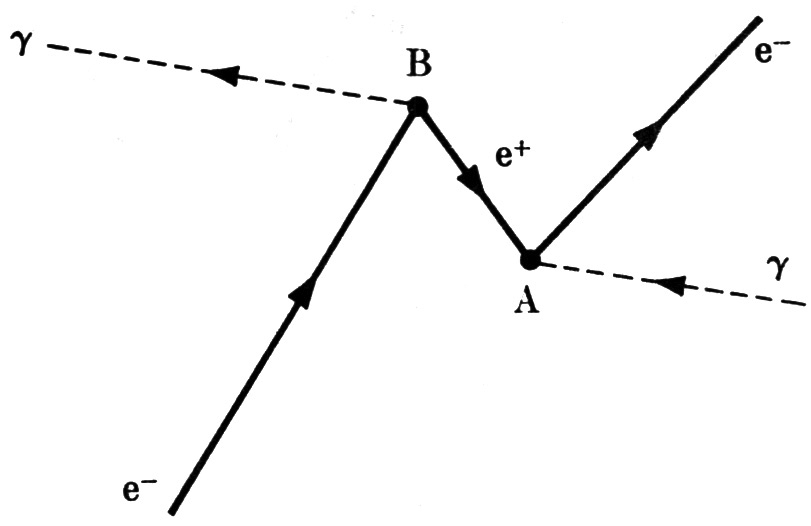 Feynman diagram for the process of photon-electron scattering.
Feynman diagram for the process of photon-electron scattering.
1 This process is electron-photon scattering, known as the Compton effect. When it was discovered by Arthur Compton in 1923, it added strong support to the photon concept of light.
